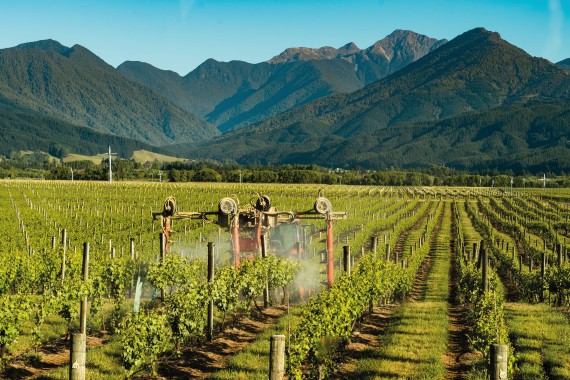Just over a year ago, former DI editor Martin Green reported on New Zealand’s surging exports for Decanter magazine. In the report Clive Jones, chairman of New Zealand Winegrowers, said: “The New Zealand wine industry is now the most export-focused of all the world’s wine industries, with close to 90% of sales occurring outside our home market. Th e $450 million growth in export value in the past year testifies to the strong consumer demand for New Zealand wine in key markets, particularly Sauvignon Blanc.”
However, much has changed in just 12 months and a more recent account by New Zealand Winegrowers for the year ending June 2024 shows an 11% drop in exports on the previous year. Furthermore, the ominous report by the International Organisation of Wine & Vine (OIV), on page six of this issue, shows New Zealand’s 2024 wine export volume (2.7mhl) and value (€1.1bn) decreased by 0.9% and 6.1%, respectively. And according to the Observatory of Economic Complexity, New Zealand was the third-biggest exporter to the US in 2024, accounting for just over half a billion US dollars.
What seemed an impenetrable surge in overseas sales has suddenly done a U-turn, and given that the US is its biggest export market, the 10% tariff from Donald Trump further laments the situation.
However, following the positive thoughts of OIV director general John Barker from page six, he references sustainability as one of the future-proofing methods for the wine trade.
Sustained focus
Th e 2025 edition of the New Zealand Winegrowers Sustainability Report states that 98% of all the vineyard area in the country is now certified sustainable through the Sustainable Winegrowing New Zealand programme, which celebrates its 30th anniversary this year. The report also states that 90% of the wine produced is processed domestically, while 16% of New Zealand wineries hold organic certification.
“The New Zealand wine industry remains committed to a sustainable future, a vision that industry leaders have been championing for over 30 years,” reads the report.
“Despite current turbulent global trade winds, the reputation of the New Zealand wine industry for high-quality, distinctive and sustainable wines remains a constant, and the industry is focused on protecting its hard-won reputation for generations to come.”
According to the report, the organisation plans to be net zero on carbon emissions by 2050 and currently 68% of member wineries are implementing initiatives to minimise their carbon footprint; 63% of wineries are using lightweight glass bottles; 40% of wineries have energy efficiency initiatives and 15% have installed solar energy sources.
As for vineyards, 56% are implementing initiatives to minimise their carbon footprint; 29% have energy-efficiency initiatives; 30% are upgrading their equipment to reduce energy consumption and 7% have dedicated property plantings that act as carbon sinks.
The report also lays out the ways in which NZ vineyards and wineries are addressing industry goals relating to water, people, soil, waste and plant protection.
A total of 94% of vineyards optimise their water applications for irrigation; 99% of vineyards and wineries have waste reduction and recovery/recycling programmes; 81% of wineries have waste reduction initiatives and 99% of vineyards use non-chemical methods for managing pests and diseases.
Of course, there’s a deep irony in these ambitious goals given that around 90% of the country’s wine is exported. Consumers are more carbon conscious today than ever before and eventually their buying habits will begin to reflect this, which is bad news for an export-focused region. In fact, for the future-proofing of New Zealand wine it’s crucial that it becomes a leading example in sustainable wine practices, especially with the troubled headwinds in its prized exports and a turbulent US market under Trump.
Positive report
Regardless of the country’s export struggles, the quality of its wines is certainly there. Patrick Materman, director of winegrowing at Villa Maria, provides his positive outlook on the latest harvests in the country’s most important regions.
“The 2025 vintage is shaping up to be one to remember, with standout quality across our growing regions.
“Hawke’s Bay experienced the driest yet coolest summer for at least five years. Chardonnay arrived in exceptional condition, showcasing vibrant acidity and concentrated flavour. Sauvignon Blanc, Pinot Gris, and the Merlot grapes for our rosé from the Heretaunga Plains have also impressed, with lifted aromatics and bright citrus notes. The fruit has ripened evenly, and cooler sites like the Tukituki Valley delivered fruit with beautiful freshness. Reds from Gimblett Gravels were harvested next, with early Merlot and Malbec showing great colour and flavour intensity.
“In Gisborne, January was the coolest for the region in 35 years, but like Hawke’s Bay, the sun returned in time for a smooth harvest. Chardonnay, Pinot Gris and Sauvignon Blanc came in ripe and clean. Fruit volumes are back to normal following two smaller harvests in this region, and the standout so far is Chardonnay, which is full of promise for both still and sparkling styles.
“In Marlborough, the Pinot Noir has all been harvested and is showing excellent colour and perfume in the red cellar. With exceptional weather over flowering, Sauvignon Blanc yield potential was abundant and required careful management. Warm, dry conditions from early February right through to the end of harvest has led to clean, fresh and vibrant flavours; all the hallmarks of delicious Marlborough Sauvignon Blanc. With many of the components still fermenting, we’re optimistic around putting some superb blends together.”

